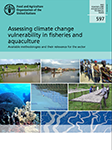The Food and Agriculture Organization of the UN (FAO) has released a technical study titled 'Assessing Climate Change Vulnerability in Fisheries and Aquaculture: Available Methodologies and their Relevance for the Sector,' which provides an overview of vulnerability assessment methodologies and their application in the fisheries and aquaculture sector.
 6 November 2015: The Food and Agriculture Organization of the UN (FAO) has released a technical study, titled ‘Assessing Climate Change Vulnerability in Fisheries and Aquaculture: Available Methodologies and their Relevance for the Sector,’ which provides an overview of vulnerability assessment methodologies and their application in the fisheries and aquaculture sector.
6 November 2015: The Food and Agriculture Organization of the UN (FAO) has released a technical study, titled ‘Assessing Climate Change Vulnerability in Fisheries and Aquaculture: Available Methodologies and their Relevance for the Sector,’ which provides an overview of vulnerability assessment methodologies and their application in the fisheries and aquaculture sector.
The study outlines the need for vulnerability assessments in fisheries and aquaculture and provides an overview of concepts of and perspectives in vulnerability. It then develops a classification of assessment methodologies that distinguishes between top-down/quantitative, bottom-up qualitative, and integrated methodologies. The study further describes issues such as data availability and confidence, measures and indicators, communication of results, and good practices for vulnerability assessments.
The subsequent section discusses six case studies of how different methodologies have been used to assess vulnerability of aquaculture and fisheries from different perspectives, including national economies, ecosystems, communities or species. The case studies focus on, inter alia: the vulnerability of national economies to global climate change through fisheries and aquaculture; Pacific Island counties and territories; coral bleaching in Kenya; fisheries-dependent communities in the Benguela current region; fisheries and aquaculture species and production systems in the lower Mekong basin; and the US national marine fisheries service.
The remaining sections develop steps for a harmonized vulnerbility assessment process for fisheries and aquaculture and offer reflections on how such vulnerability assessments can inform actions and policies.
The conclusions highlight that assessment methodologies must be chosen in accordance with the assessment’s purpose, and notes that interpreting the results of vulnerability assessments requires careful attention to the assumptions and limitations of the methodologies used and sensitivity to stakeholder values and perceptions of vulnerability. [Publication: Assessing Climate Change Vulnerability in Fisheries and Aquaculture: Available Methodologies and their Relevance for the Sector]